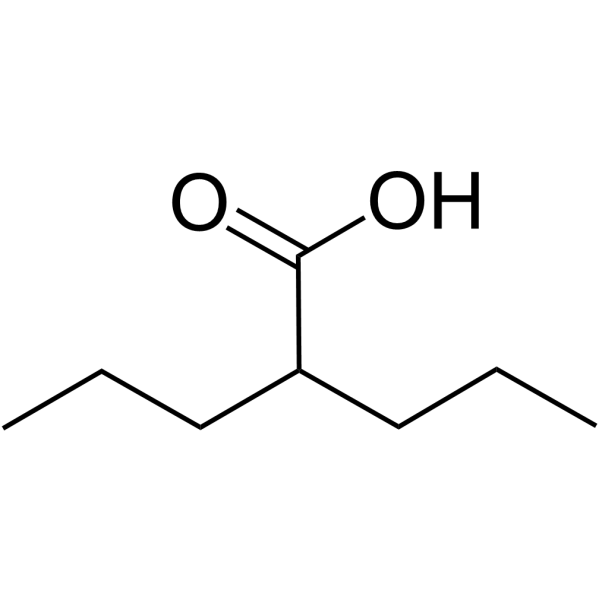上海金畔生物科技有限公司为生命科学和医药研发人员提供生物活性分子抑制剂、激动剂、特异性抑制剂、化合物库、重组蛋白,专注于信号通路和疾病研究领域。
Valproic acid (Synonyms: 丙戊酸; VPA; 2-Propylpentanoic Acid) 纯度: ≥98.0%
Valproic acid (VPA; 2-Propylpentanoic Acid) 是一种 HDAC 抑制剂,IC50 值为 0.5-2 mM,抑制 HDAC1 的活性,(IC50,400 μM),同时可诱导 HDAC2 的降解。Valproic acid 激活 Notch1 信号并抑制小细胞肺癌 (SCLC) 细胞的增殖。Valproic acid 可用于癫痫、双相情感障碍和偏头痛等的研究。

Valproic acid Chemical Structure
CAS No. : 99-66-1
| 规格 | 价格 | 是否有货 | 数量 |
|---|---|---|---|
| Free Sample (0.1-0.5 mg) | Apply now | ||
| 500 mg | ¥350 | In-stock | |
| 1 g | ¥450 | In-stock | |
| 5 g | ¥800 | In-stock | |
| 25 g | ¥1900 | In-stock | |
| 50 g | 询价 |
* Please select Quantity before adding items.
Valproic acid 相关产品
•相关化合物库:
- Drug Repurposing Compound Library Plus
- FDA-Approved Drug Library Plus
- FDA-Approved Drug Library Mini
- Bioactive Compound Library Plus
| 生物活性 |
Valproic acid (VPA; 2-Propylpentanoic Acid) is an HDAC inhibitor, with IC50 in the range of 0.5 and 2 mM, also inhibits HDAC1 (IC50, 400 μM), and induces proteasomal degradation of HDAC2. Valproic acid activates Notch1 signaling and inhibits proliferation in small cell lung cancer (SCLC) cells. Valproic acid sodium salt is used in the treatment of epilepsy, bipolar disorder and prevention of migraine headaches. |
||||||||||||||||
|---|---|---|---|---|---|---|---|---|---|---|---|---|---|---|---|---|---|
| IC50 & Target |
|
||||||||||||||||
| 体外研究 (In Vitro) |
Valproic acid (VPA; 2-Propylpentanoic Acid) inhibits the growth dose- and time-dependently with an IC50 of appr 10 and 4 mM at 24 and 72 h, respectively. Valproic acid significantly attenuates the activities of total, cytosol and nuclear HDACs. Valproic acid increases the form of acetylated histone 3 in HeLa cells. Valproic acid (1-3 mM) induces a G1 phase arrest, while 10 mM Valproic acid significantly induces a G2/M phase arrest of cell cycle in HeLa cells. In addition, Valproic acid increases the percentage of sub-G1 cells in HeLa cells in a dose-dependent manner at 24 h[1]. 上海金畔生物科技有限公司 has not independently confirmed the accuracy of these methods. They are for reference only. |
||||||||||||||||
| 体内研究 (In Vivo) |
Valproic acid (VPA; 2-Propylpentanoic Acid; 500 mg/kg, i.p.) inhibits the tumor growth and angiogenesisin the mice transplanted with Kasumi-1 cells. The IR rate in the Valproic acid group is 57.25% at the end of the experiment[2]. 上海金畔生物科技有限公司 has not independently confirmed the accuracy of these methods. They are for reference only. |
||||||||||||||||
| 分子量 |
144.21 |
||||||||||||||||
| Formula |
C8H16O2 |
||||||||||||||||
| CAS 号 |
99-66-1 |
||||||||||||||||
| 中文名称 |
丙戊酸;2-丙基戊酸;二丙基乙酸 |
||||||||||||||||
| 运输条件 |
Room temperature in continental US; may vary elsewhere. |
||||||||||||||||
| 储存方式 |
|
||||||||||||||||
| 溶解性数据 |
In Vitro:
DMSO : 100 mg/mL (693.43 mM; Need ultrasonic) H2O : 1 mg/mL (6.93 mM; Need ultrasonic and warming) 配制储备液
*
请根据产品在不同溶剂中的溶解度选择合适的溶剂配制储备液;一旦配成溶液,请分装保存,避免反复冻融造成的产品失效。 In Vivo:
请根据您的实验动物和给药方式选择适当的溶解方案。以下溶解方案都请先按照 In Vitro 方式配制澄清的储备液,再依次添加助溶剂: ——为保证实验结果的可靠性,澄清的储备液可以根据储存条件,适当保存;体内实验的工作液,建议您现用现配,当天使用; 以下溶剂前显示的百
|
||||||||||||||||
| 参考文献 |
|
| Kinase Assay [1] |
The activity of caspase-3, -8 and -9 is assessed using the caspase-3, -8 and -9 colorimetric assay kits, respectively. In brief, 1×106 cells in a 60-mm culture dish are incubated with 10 mM Valproic acid for 24 h. The cells are then washed in PBS and suspended in 5 volumes of lysis buffer provided with the kit. Protein concentrations are determined using the Bradford method. Supernatants containing 50 μg total protein are used to determine caspase-3, -8 and -9 activities. The supernatants are added to each well in 96-well microtiter plates with DEVD-pNA, IETD-pNA or LEHD-pNA as caspase-3, -8 and -9 substrates and the plates are incubated at 37°C for 1 h. The optical density of each well is measured at 405 nm using a microplate reader. The activity of caspase-3, -8 and -9 is expressed in arbitrary absorbance units. 上海金畔生物科技有限公司 has not independently confirmed the accuracy of these methods. They are for reference only. |
|---|---|
| Cell Assay [1] |
In brief, 5×105 cells are seeded in 96-well microtiter plates for MTT assays. After exposure to the designated doses of Valproic acid for the indicated times, MTT solution [20 mL: 2 mg/mL in phosphate-buffered saline (PBS)] is added to each well of the 96-well plates. The plates are additionally incubated for 3 h at 37°C. Medium is withdrawn from the plates by pipetting and 200 mL DMSO is added to each well to solubilize the formazan crystals. The optical density is measured at 570 nm using a microplate reader. 上海金畔生物科技有限公司 has not independently confirmed the accuracy of these methods. They are for reference only. |
| Animal Administration [2] |
Splenectomies are performed on the BALB/c nude mice. One week after the splenectomies, the mice receiv whole body irradiation with 137Cs at a dose of 4 Gy. At 48-72 h post-irradiation, the mice are subcutaneously implanted with Kasumi-1 cells (2×107 cells/mouse with 0.15-0.2 mL) in the right axillary region. The mice are randomLy assigned to two groups, the Valproic acid (n=6) and control (n=6) groups. When the tumors are appr 200 mm3 in size at appr 10 days post-implantation, 0.2 mL Valproic acid (500 mg/kg body weight) or 0.2 mL saline is injected intraperitoneally every day. Valproic acid is dissolved in saline at a concentration of 25 mg/mL. The longest diameter (a) and the shortest diameter (b) of the tumor are measured every three days, and the tumor volume (TV) is calculated according to the following formula: TV=1/2×a×b2. Following two weeks of injections, the mice are sacrificed by cervical dislocation and the tumor masses are removed for the following experiments. 上海金畔生物科技有限公司 has not independently confirmed the accuracy of these methods. They are for reference only. |
| 参考文献 |
|
所有产品仅用作科学研究或药证申报,我们不为任何个人用途提供产品和服务
